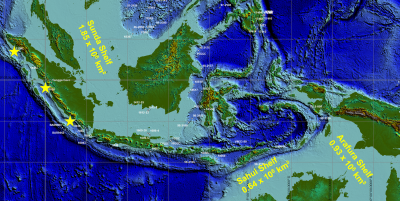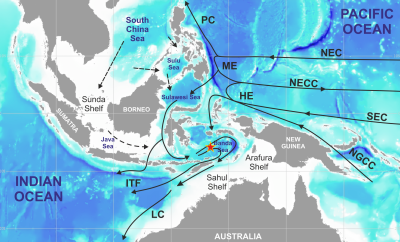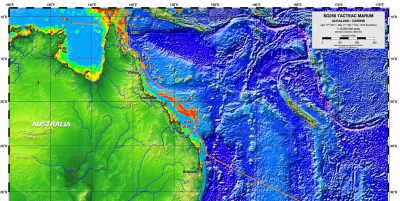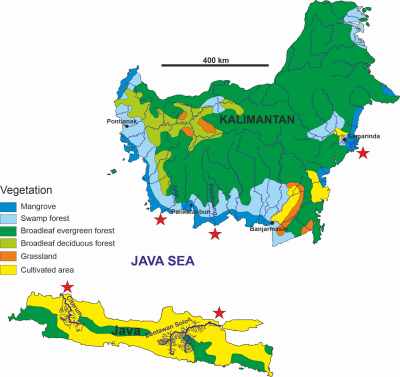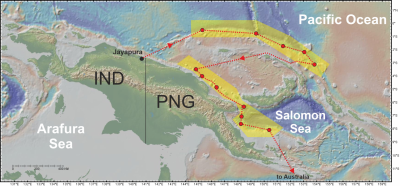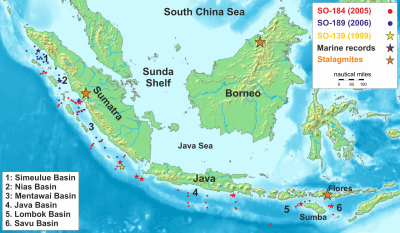IPWP
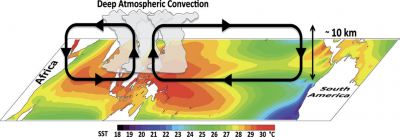
The IPWP is the largest reservoir of warm surface water on Earth and is therefore known as the Earth's heat engine. It represents the main source of heat for the global atmosphere; small SST fluctuations in the IPWP affect the location and strength of the ascending branches of the Hadley and Walker circulations, thus altering the global hydrological cycle.
We have been conducting research in this region since 2005 in collaboration with colleagues from the USA, Indonesia, Australia, Taiwan, Papua New Guinea, the Philippines, Canada and Singapore. We deal with the interaction of coupled (land-ocean-atmosphere) phenomena such as El-Niño-Southern Oscillation (ENSO), Indian Ocean Dipole Mode (IOD) and monsoon using paleo-data and different paleoclimate model simulations.
INDOCRISIS (DFG)
Indian Ocean response to rising sea-level (2023-2025)
Coastal regions offshore west Sumatra are critical for the development of largescale climate anomalies across the Indian Ocean. Changes in local sea surface and thermocline temperatures affect atmospheric convection and rainfall not only in this region but also across the globe. Simulations of future and past climate of the Indian Ocean and the surrounding landmasses remain uncertain in large part because of the deficiencies of the models in reproducing climate conditions here. In particular, the role of sea-level in shaping climate conditions since the Last Glacial Maximum is disputed, both in simulations and in reconstructions of the Indian Ocean climate. It is planned to reconstruct mean annual sea surface and thermocline temperatures together with rainfall isotopes in three sedimentary records offshore west Sumatra since the Last Glacial Maximum. In addition, the range of sea surface and thermocline temperatures will be measured in five different sea-level stands in order to assess the range (or stability) of these parameters during those periods. This endeavor allows detecting whether changes in sea-level were capable of changing the ocean and atmosphere conditions in this region and triggering basin-wide anomalies in circulation and rainfall.
BASE-ITF (DFG)
Banda Sea and the Indonesian Throughflow variability during the past 700,000 years (2021-2023)
The Banda Sea is a critical basin in mixing and modifying of the subsurface water masses entering the Indian Ocean from the Pacific Ocean, called the Indonesian Throughflow (ITF). Mixing of the relatively saltier South Pacific and fresher North Pacific source waters of the ITF takes place here, where the depth and temperature of the thermocline are capable of generating large atmospheric feedbacks and rainfall anomalies. However, the contribution of South Pacific water masses to the ITF is unknown due to the lack of instrumental records and proxy-based reconstructions from the Banda Sea.
We study 700,000 years of surface and thermocline conditions from shell Mg/Ca and δ18O of two planktic foraminifera species from a marine core in the Banda Sea. By reconstructing the upper water conditions in the Banda Sea from multi-centennial to orbital timescales and under different climate boundary conditions, we will elucidate the relative contributions of the different source waters to the ITF, their relation to sea-level changes, and to convection and rainfall over Indonesia.
TACTEAC (BMBF)
Temperature and circulation history of the East Australian Current (2017-2019)
The East Australian Current (EAC) is one of the two main western boundary currents of the Pacific that transports large amount of heat out of the Western Pacific Warm Pool into the subtropics and subpolar regions, thereby regulating the global climate. The few existing reconstructions of past changes in transport and temperature of the EAC are contradictory resulting in a knowledge gap in long-term variability of the southwest Pacific currents, which in turn hampers a reliable projection of future tropical and subtropical climate development.
In this project we collect and study sediments along the EAC between 12° and 26°S in order to assess seasonal to multi-millennial changes in sea surface temperature and circulation of the Coral Sea and their effect on regional climate.
CAFINDO (BMBF)
Climate versus anthropogenic forcing of Late Holocene environmental change affecting Indonesian marine, coastal, and terrestrial ecosystems (2013-2016)
The extent to which environmental variability in Indonesia on historical time scales is caused by human impact is not known due to the lack of archives that allow comparing natural versus anthropogenic forcing.
In this project we reconstruct late Holocene sea surface temperature and salinity of the Java Sea, and the amount and composition of the load of major rivers draining the islands of Kalimantan and Java. Kalimantan rivers Mahakam, Jelai and Pembuang were largely unaffected by human interference until the last century, and are characterized by a strong control of ENSO and monsoon on rainfall in their catchment. In contrast, the two Javanese rivers Solo River and Citarum have been strongly affected by human impact over historical times. Comparing the historical development of these river catchments will allow untangling the contributions of natural and anthropogenic forcing in this region.
WESTWIND (BMBF)
Hydrology of the Western Pacific Warm Pool and its influence on the Indonesian Throughflow (2013-2015)
The hydrologic cycle of the Western Pacific Warm Pool (WPWP) is presently influenced by variations in El Niño-Southern Oscillation (ENSO) as well as by high latitude climate. Despite the significance of this cycle for the regional climate and its active role in global circulation, its long-term variation and its influence on the Indonesian Throughflow (ITF) are largely unknown.
We study rapidly accumulating sediments offshore Papua New Guinea, a critical region for understanding the response of the tropical hydrologic cycle to different forcings, but with very few high-quality paleoclimate reconstructions. Reconstructing the zonal and meridional gradients in temperature, salinity, and precipitation enables us to isolate the relative influence of different potential forcings under different scenarios.
ENSO-IOD-Variability (DFG)
Centennial to millennial variability of ENSO and IOD in the eastern Indian Ocean over the last 30,000 years (2009-2011)
Recent studies agree that the Indonesian Archipelago plays a key role in present and past global climate. However, both proxy-based and modelling results differ when reconstructing the regional climate and its global implications, particularly on centennial to millennial timescales and during abrupt climate changes. These studies underline the need for hitherto missing high-resolution proxy evidence from the eastern Indian Ocean W and SW of the Indonesian Archipelago, a key region in tropical climate dynamics especially with regard to the Indian Ocean Dipole (IOD) and El Niño-Southern Oscillation (ENSO).
Using planktonic foraminifera-based geochemical proxies in high-resolution sediment cores from off W- and SW-Indonesia, we reconstruct past variations in the regional hydrography that is strongly affected by IOD/ENSO events. We interpret these results in order to reconstruct past intensity of the IOD and its link to ENSO on the above mentioned timescales. This project provides clues on the long-term behavior of these phenomena under different climate states and boundary conditions.



